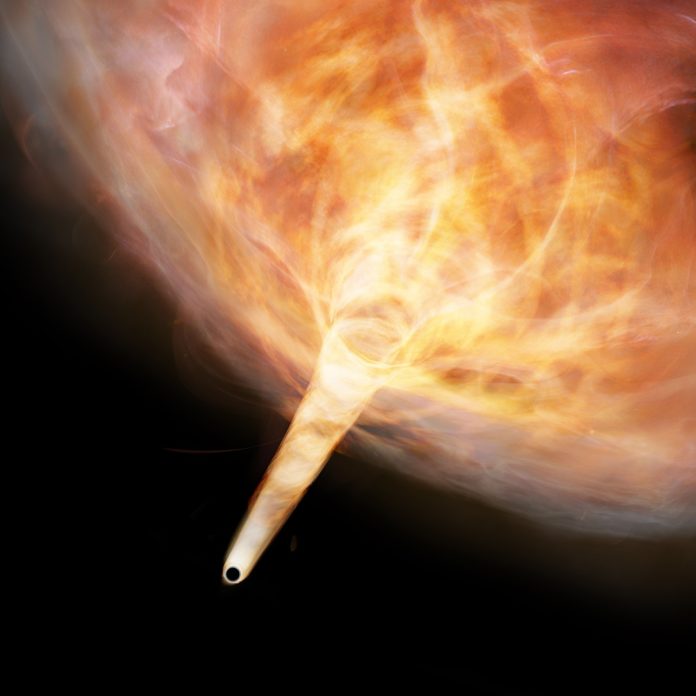
A team led by the Astronomers have discovered a stray black hole is lurking in the corner of our Milky Way galaxy, while the scientists in Japan examining a molecular cloud with enigmatic motion. Though it is difficult to find black holes as even light can’t escape them that they are completely black. But in some times black holes cause effects which can be seen, astronomers have found ways to spot them through the effects they have on nearby celestial objects.
“We found a new way of discovering stray black holes,” said Professor Tomoharu Oka, an Astrophysics professor at Keio University and author of the study in a statement.

Of the 100 million to one billion of black holes’ researchers suspect are floating around in our milky way galaxy, although only 60 or so have been found through observations to date. The closest black hole that we know of is around 3,000 light-years away. Black hole is one of the most terrifying thing in our existence, a region of space-time where matter is embraced together so tight. It has a strong gravitational effect that nothing can escape from it, not even particles and electromagnetic radiation such as light.
We know what matter surrounds around the black holes. If a black hole has a companion star, the black hole become visible due to the super-hot ring of gas. Gas streaming into the black hole piles up around it and forms a disk, that heats up due to the enormous gravitational pull by the black hole and forcing disk to emit intense radiation (X-rays). The super-hot gas ring surrounds it as it pulls matter from the star to oblivion. But it’s nearly impossible to locate, if a black hole is floating by itself in our galaxy.

The Study, published in The Astrophysical Journal Letters, was performed by Tomoharu Oka, a professor at Keio University and Masaya Yamada, a graduate student at Keio University, Japan. The team used the ASTE Telescope in Chile and the 45 metre (148 feet) Radio Telescope at Nobeyama Radio Observatory, to observe molecular clouds around the remnant of a supernova explosion called SNR W44, which is located 10,000 light-years away from Earth. In the course of their study, the researchers began to find some strange indicators at the edge of W44.
The team was interested in how much energy was transferred to the surrounding molecular gas from the supernova explosion, but, in the process, they stumbled upon signs of a hidden black hole (a fast-moving cosmic cloud of molecules tearing through the Milky Way). To investigate the origin of this cloud, they’ve nick-named it the unknown phenomenon the ‘Bullet’ and they think the new discovery could help know where more of them are lurking.

What they saw was a cloud which moved faster than could be accounted for by the supernova alone. “It’s kinetic energy is a few tens of times larger than that injected by the W44 supernova, it seems impossible to generate such an energetic cloud under ordinary environments.” says lead researcher Masaya Yamada.
This compact molecular cloud, named the Bullet, has a speed and moving forward at more than 100 kilometres per second (62 miles per second) and expanding at 50 kilometres per second (31 miles per second), that exceeds the speed of sound in interstellar space by more than two orders of magnitude.
“Most of the Bullet has an expanding motion with a speed of 50 km/s, but the tip of the Bullet has a speed of 120 km/s,” said lead researcher Masaya Yamada.
The cause of this cloud’s ridiculous speed isn’t clear, but two hypotheses for the Bullet’s formation require a black hole to be present.
The first is the “explosion model” — The gas shell of the supernova remnant passed by a static black hole, creating an explosion (the black hole pulls the gas very close to it). This would accelerate the gas toward us after the gas shell has passed the black hole.
The second is the “irruption model” — A fast-moving black hole stormed through a cloud of dense gas and dragged it along by the strong gravity of the black hole to form a gas stream.

All these signs are pointing towards a dark and compact gravity source, possibly a black hole has an important role in the formation of the Bullet that is up to 36 times more massive than sun.
The team expects to unscramble the two scenarios (explosion model and irruption model) and find more solid evidence to confirm the existence of a black hole in the fast-moving cloud Bullet with higher resolution observations using a radio interferometer, such as the Atacama Large Millimetre/submillimetre Array (ALMA) in Chile.



























